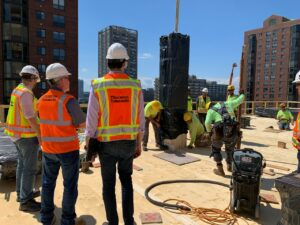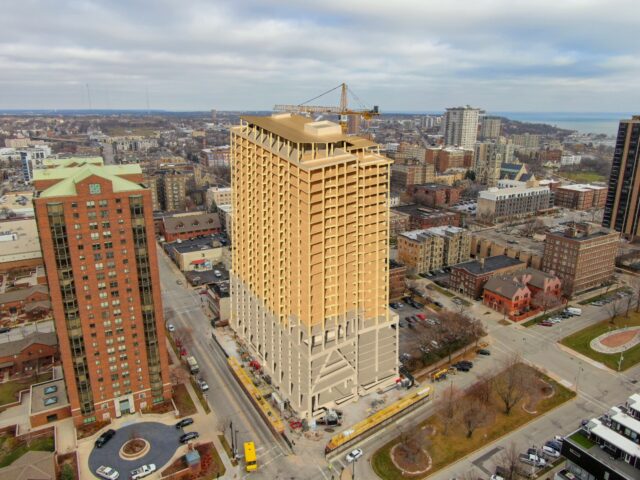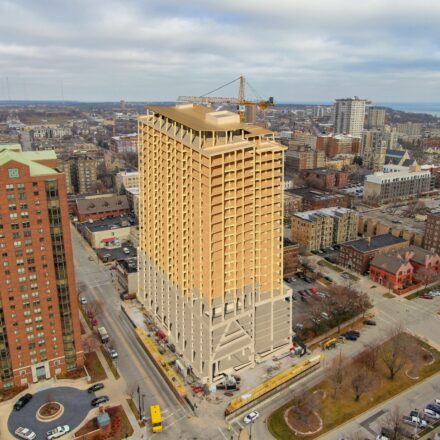By Kathryn Nave
Constructed in 1056, the nine-story Sakyamuni Pagoda of Fogong Temple rises 220 feet above the city of Shuozhou in Northern China. It has survived numerous violent earthquakes and for centuries has remained unchallenged as the tallest wooden building anywhere in the world.
“Wood is one of our oldest building materials,” explains Andrea Frangi, professor for Timber Structures at ETH Zurich. “We used to build entire cities out of timber; we have timber buildings with a very long history that show you how durable it is.”
Yet, with the advent of the industrial revolution, steel and concrete have become the new basic ingredients of the construction industry. That transition may have fueled the growth of vertical cities, but it has also had dire consequences for the environment. The construction industry now accounts for around 40% of global CO2 emissions—a large proportion of which is due to the energy-intensive production of steel and concrete.
With the number of people living in cities expected to double by 2050, engineers and architects are increasingly returning to wood to see whether it can meet people’s appetite for high-rise living without destroying the climate in the process.
Carbon-negative construction
This trend has largely been driven by the densely forested countries of northwestern Europe, with the construction of increasingly high-rise towers such as the 275-foot HoHo Wien tower in Austria and Norway’s 280-foot high Mjøstårnet, both completed in 2019, followed by Sweden’s 246-foot Sara Kulturhus, inaugurated in September last year.

Now timber towers are spreading across the world. Last December, the record for tallest timber building passed to the U.S., following the topping-out of the central structure for the 284-foot tall Ascent tower in Milwaukee (which officially opened its doors in July).
“If you compare the energy needed to heat steel or cement to create a support beam or a concrete block, the energy needed for the production of mass timber is significantly lower,” explains Jordan Komp, associate principal at Thornton Tomasetti, the structural engineering firm behind Ascent. “Add in the fact that trees sequester carbon as they grow, and you have the potential to move towards that target of net-zero emissions—or even below.”
While these wooden high-rises may begin their life in the same forest as a log cabin, the components used in mass timber projects are much less rustic. In Ascent, thick glue-laminated beams replace steel girders, while the flooring is constructed from cross-laminated panels, in which thin sheets of timber are layered perpendicular to one another.
A cost-competitive building material
Beyond the climate imperative to investigate more sustainable materials, the rising costs of steel and concrete are rendering these timber alternatives increasingly cost-competitive.
“The steel market is crazy right now, and in some cases, materials cost nearly double what they used to a handful of years ago,” Komp says. “At this point, mass timber is probably comparable in cost to steel, and a little more expensive than concrete.”
While timber was also impacted by the COVID-19 supply chain crisis, with average costs in the U.K. experiencing a similar price increase to steel, Komp believes that timber is more likely to see an improved supply chain and decreasing costs in the longer term as manufacturers scale up to meet the growing popularity of mass timber constructions.

“There is a vast amount of underutilized forest land,” he says. “Utilizing these forest means generating revenue which can then be put back into managing and maintaining these forests in a sustainable manner that is good for the environment. I 100% believe it is possible to meet the demand for mass timber from sustainably managed forests.”
It’s not only the climate that stands to benefit from mass timber construction methods. Timber can be engineered to provide comparable strength to other construction elements at less than half the weight, meaning foundations don’t need to be dug as deep.
“Your speed of construction and disruption to the environment is also going to be decreased because most of the components are manufactured off-site,” Komp says. “Then there’s our attraction to the beauty of natural materials like wood. From a consumer standpoint, there are huge benefits to utilizing mass timber.”
Natural fireproofing
Given these advantages, why has the potential of wood in large-scale construction been neglected for so long? As Frangi points out, engineered timber is not a new material, but the association of wood with flammability has been a factor in preventing its adoption in large-scale constructions.
That association, as both he and Komp stress, is based on a misguided comparison between the large beams used in mass timber construction with the thin wooden frames that make up a traditional wooden house.

“If you think of starting a fire you can’t just go straight to big logs; you need the little pieces of kindling to get it started,” Komp says. “Once the large pieces of wood start to burn, they form a layer of char which insulates the inside. This means large pieces of wood can maintain their structural integrity for several hours and even self-extinguish. You can actually use wood to protect steel from fire.”
Nonetheless, regulators have historically adopted a conservative attitude when it comes to regulating the use of wood as a building material. While Switzerland used to forbid building above two stories, it has allowed wooden buildings of any size since 2015. In the U.S., cities and states have only started to relax their building codes more recently, following an update to the International Building Code last year, which now approves mass timber for use in buildings of up to 18 stories.
“In order to get approval for building to 25-stories, we had to conduct tests to prove that the columns would survive a three-hour fire,” Komp explains. “There was never any doubt it was going to pass, but we didn’t have the data because no one has ever tested for that long before.”
As more tall timber towers are built, and stakeholders gain experience with them, Frangi believes local regulations will increasingly adapt to support their construction.
“There is huge potential here,” he says. “The population is growing and increasingly moving into cities. Construction is booming, but we cannot use the same resources as we have been doing. We have to find a way to meet that need for dwellings without relying on steel and concrete.”
Lead image of the Ascent 3D-rendering courtesy of Thornton Tomasetti.

